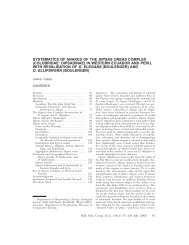cryptic species within the dendrophidion vinitor complex in middle ...
cryptic species within the dendrophidion vinitor complex in middle ...
cryptic species within the dendrophidion vinitor complex in middle ...
Create successful ePaper yourself
Turn your PDF publications into a flip-book with our unique Google optimized e-Paper software.
SPECIES IN THE DENDROPHIDION VINITOR COMPLEX N Cadle 219<br />
A general pattern <strong>in</strong> <strong>the</strong> arrangement of<br />
calyxlike structures seems common to all<br />
<strong>species</strong> of Dendrophidion, regardless of <strong>the</strong><br />
overall pattern <strong>in</strong> a given <strong>species</strong>. Calyces<br />
are most fully developed on <strong>the</strong> asulcate<br />
side <strong>in</strong> comparison to <strong>the</strong> sulcate side, which<br />
has few or no full-fledged calyces. On <strong>the</strong><br />
asulcate side <strong>in</strong> most <strong>species</strong>, a calyculate<br />
region extends to <strong>the</strong> tip of <strong>the</strong> apex,<br />
sometimes as far as its midpo<strong>in</strong>t. Additionally,<br />
at <strong>the</strong> proximal edge of <strong>the</strong> calyculate<br />
region, at least one pair of transverse<br />
flounces encircles <strong>the</strong> hemipenis <strong>in</strong> all<br />
<strong>species</strong> (some <strong>species</strong> have more than one<br />
pair). Transitions between flounces and<br />
calyces or calyxlike structures occur abruptly<br />
<strong>with<strong>in</strong></strong> a s<strong>in</strong>gle organ.<br />
The sulcus spermaticus <strong>in</strong> Dendrophidion<br />
is centrol<strong>in</strong>eal and usually has a slightly flared<br />
tip with divergent sulcus lips, but <strong>the</strong> sulcus is<br />
term<strong>in</strong>ally divided <strong>in</strong> an undescribed <strong>species</strong><br />
of <strong>the</strong> D. percar<strong>in</strong>atum group and <strong>in</strong> D.<br />
dendrophis (a detailed discussion of this<br />
morphology will be presented elsewhere).<br />
Savage (2002: 539) <strong>in</strong>troduced <strong>the</strong> term<br />
semicentripetal for sulcus conditions such as<br />
those Dendrophidion with a simple sulcus on<br />
a unilobed organ <strong>in</strong> which <strong>the</strong> sulcus extends<br />
to <strong>the</strong> tip of <strong>the</strong> hemipenis with m<strong>in</strong>imal<br />
deviation from <strong>the</strong> midl<strong>in</strong>e of <strong>the</strong> sulcate<br />
surface (e.g., hemipenes described here<strong>in</strong>).<br />
This term is unnecessary because it embodies<br />
several aspects of hemipenial morphology for<br />
which vocabulary already exists, namely <strong>the</strong><br />
overall hemipenial form (unilobed vs. bilobed),<br />
sulcus morphology (simple vs. bifurcate),<br />
and sulcus orientation (centrifugal,<br />
centrol<strong>in</strong>eal, or centripetal). Because <strong>the</strong>se<br />
three aspects of hemipenial morphology can<br />
be comb<strong>in</strong>ed <strong>in</strong> various ways, I prefer to<br />
employ terms that keep <strong>the</strong> descriptive<br />
concepts separate. Thus, I use centrol<strong>in</strong>eal<br />
to refer to simple or bifurcate sulci that pass<br />
distally with little deviation from <strong>the</strong> <strong>middle</strong><br />
of <strong>the</strong> sulcate side of a hemipenis, whe<strong>the</strong>r<br />
unilobed or bilobed. O<strong>the</strong>r authors (e.g.,<br />
Zaher [1999] and Myers [2011]) have also<br />
used centrol<strong>in</strong>eal <strong>in</strong> this broader sense.<br />
The use of <strong>the</strong> term semicentripetal has<br />
o<strong>the</strong>r awkward consequences. First, semicentripetal<br />
suggests a relationship to centripetal<br />
sulci seen on many bifurcate hemipenes.<br />
This relationship is unclear given<br />
that simple sulci can be derived <strong>in</strong> several<br />
ways from dist<strong>in</strong>ct bifurcate morphologies<br />
(centripetal, centrol<strong>in</strong>eal, or centrifugal),<br />
and hemipenes <strong>in</strong> colubrids may have sulci<br />
<strong>in</strong> any of <strong>the</strong>se orientations (Cadle, 2010:<br />
18–19; see also Myers, 2011: 22–24).<br />
Secondly, some genera (e.g., Dendrophidion,<br />
Leptodeira, Taeniophallus) have <strong>species</strong><br />
with both divided and simple sulci spermatici<br />
on unilobed to slightly bilobed organs;<br />
see Schargel et al. (2005, fig. 8) for an<br />
example from Taeniophallus and Myers<br />
(2011: 22–24) for Leptodeira. Us<strong>in</strong>g semicentripetal<br />
for those <strong>species</strong> with a simple<br />
sulcus and centrol<strong>in</strong>eal for those with a<br />
divided sulcus has <strong>the</strong> undesirable consequence<br />
of apply<strong>in</strong>g different names to<br />
sulcus orientations that are basically <strong>the</strong><br />
same, <strong>the</strong> only difference be<strong>in</strong>g <strong>the</strong> simple<br />
or divided nature of <strong>the</strong> sulcus overall. The<br />
different terms obscure <strong>the</strong> clear relation<br />
between <strong>the</strong> simple and divided sulcus<br />
conditions <strong>with<strong>in</strong></strong> such genera.<br />
The use of centrol<strong>in</strong>eal for forked or<br />
simple sulci on ei<strong>the</strong>r bilobed or unilobed<br />
hemipenes means that <strong>the</strong> term applies to a<br />
broader array of sulcus topologies than<br />
would be <strong>the</strong> case if it were used exclusively<br />
for forked sulci on uni- or bilobed organs<br />
(its orig<strong>in</strong>al def<strong>in</strong>ition, used <strong>in</strong> conjunction<br />
with describ<strong>in</strong>g <strong>the</strong> morphology of some<br />
dipsadids; Myers and Campbell, 1981: 16). I<br />
believe this is a nonissue <strong>in</strong>asmuch as I use<br />
<strong>the</strong> terms centrol<strong>in</strong>eal, centripetal, and<br />
centrifugal to refer only to <strong>the</strong> position of<br />
<strong>the</strong> sulcus on <strong>the</strong> hemipenis overall, regardless<br />
of variations <strong>in</strong> o<strong>the</strong>r aspects of hemipenial<br />
morphology such as lobation or<br />
whe<strong>the</strong>r <strong>the</strong> sulcus is bifurcate or simple.<br />
O<strong>the</strong>r variations, such as deflections of a<br />
simple (centrol<strong>in</strong>eal) sulcus to <strong>the</strong> right (as<br />
<strong>in</strong> Colubridae) or left (<strong>in</strong> Natricidae) lobe,<br />
can simply be described or accommodated<br />
by terms already <strong>in</strong> use (e.g., dextral and<br />
s<strong>in</strong>istral, respectively; Rossman and Eberle,<br />
1977; Myers, 2011: 14). I believe that us<strong>in</strong>g<br />
terms such as centrol<strong>in</strong>eal for discrete<br />
Bullet<strong>in</strong> of <strong>the</strong> Museum of Comparative Zoology harv-160-04-01.3d 11/4/12 19:59:45 219







